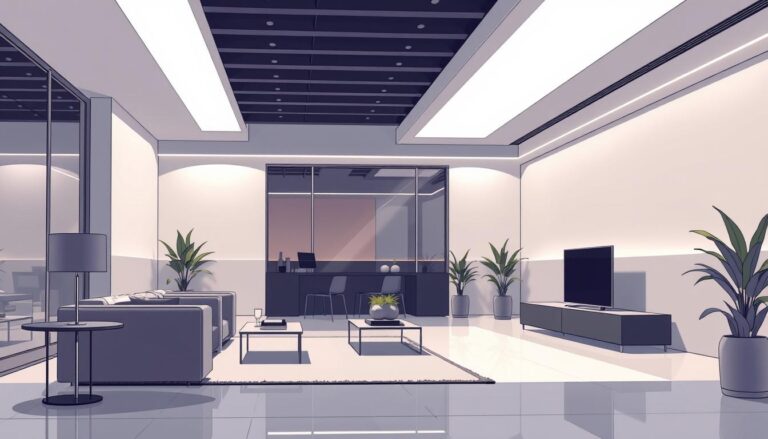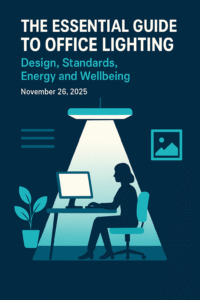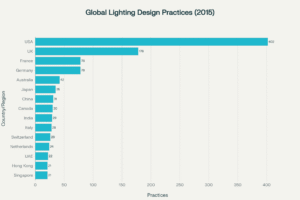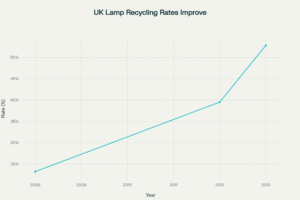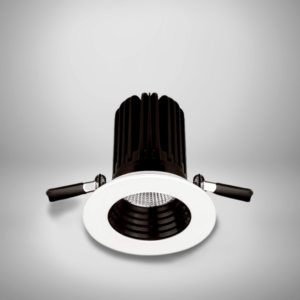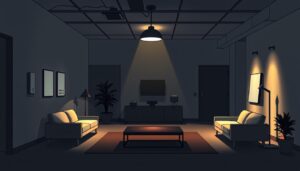Did you know LED lighting can cut energy use by up to 75% compared to old-style lights? At Lumenloop, we see lighting differently. It’s not just about making things bright. It’s about creating spaces that are effective, beautiful, and eco-friendly.
In this Guide to Linear Lighting, we’ll uncover a wide range of products on offer. They play a big role in lighting commercial offices. From lights that warm up a room with a 3000K glow for relaxing to brighter 4000K ones for more energy, thoughtful lighting makes any place better.
Lighting design is leaning more towards eco-friendly choices. We’re here to share key knowledge. We’ll talk about the perks of LED linear lights, how they’re used, and how they change spaces for the better. Discover with us how Lumenloop is leading towards a greener future in lighting. This means less waste from used lights.
Introduction to LED Linear Systems
Exploring LED linear systems opens up a world of creativity. These innovative fixtures add beauty while being energy-efficient. They redefine spaces, saving costs significantly.
This technology is a cornerstone in modern design. It’s applied in various settings due to its versatility.
Benefits of Using LED Linear Lights
LED linear lights offer great advantages. They are ideal for homes and businesses alike. Here’s why they stand out:
- Longevity: Their long life means less need for replacements.
- Energy Efficiency: They use less power, saving money and helping the planet.
- Cost Savings: With fewer maintenance needs, they are cost-effective over time.
- Improved Atmosphere: They enhance the look and feel of any space, making it more inviting.
Key Applications for Linear Luminaires
These lights are incredibly flexible. They’re used in many different places. Let’s see where:
- Commercial Spaces: They brighten offices, shops, and showrooms, boosting productivity and display quality.
- Residential Areas: Ideal for under-cabinet, closet, and staircase lighting at home.
- Architectural Accents: Perfect for highlighting modern design elements like columns and coves.
- Outdoor Uses: Durable for outdoor conditions, they enhance exterior visibility and beauty.
Comparison with Traditional Lighting Solutions
When we compare LED linear fittings to traditional options, the benefits are clear. Here’s a brief overview:
| Feature | Traditional Lighting | LED Linear Systems |
|---|---|---|
| Lifespan | 1,000 hours | 25,000+ hours |
| Energy Consumption | High | Low |
| Maintenance Costs | Frequent | Minimal |
| Environmental Impact | Higher emissions | Lower emissions |
Types of Linear Lights
Linear lighting is perfect for both home and business use. It comes in designs like surface-mounted and recessed, meeting different tastes and needs. So, knowing the types helps us make the best lighting decisions.
Surface-Mount vs. Recessed Options
Choosing between surface-mount and recessed lighting depends on what we need. We think about how it looks, how it works, and how it fits the space.
- Surface-Mount Fixtures: These LED linear fixtures are easy to pop into place. They work great in kitchens and offices, giving strong light with a simple look.
- Recessed Lights: For a clean, hidden lighting effect, recessed is the way to go. They blend into the ceiling or walls, keeping interiors sleek without losing light quality.
Flexible and Adjustable Linear Lights
Today’s linear lighting can change to fit our needs. With options like LED tape lights, we can adjust light direction and strength. This makes them perfect for places that always evolve, like showrooms and art studios.
| Type | Installation | Best For | Key Features |
|---|---|---|---|
| Surface-Mount | Easy to install | Kitchens, Offices | Strong illumination, aesthetic appeal |
| Recessed | Integrated into surfaces | Modern Interiors | Sleek design, unobtrusive |
| Suspended | Height adjustable | Open Spaces | Versatile design, connectable fixtures |
| Track | Customizable & adjustable | Varied designs | Flexible length configurations |
| LED Strip Lights | Flexible application | Accent, Under-Cabinet | Thin, adaptable |
Track Lighting
The Stucchi OneTrack is a streamlined, versatile solution for modern lighting projects. Designed for maximum compatibility, it works seamlessly with a wide range of fixtures, making it a favorite among designers and architects. Its sleek appearance adds a sophisticated touch to any space, while its robust, easy-to-configure design ensures durability and adaptability.
Whether you’re planning a retail display, office, or home setup, OneTrack provides a reliable and stylish way to achieve flexible, high-quality lighting.
Understanding Colour Temperature
Understanding colour temperature is key to making a space look and feel just right. It’s about how warm or cool the light is. We use Kelvin (K) to measure it, with red tones at 1000K and blue tones at 10,000K. Choosing the right colour temperature helps make a space not just beautiful, but also practical.
What is Colour Temperature?
Colour temperature tells us how light looks to our eyes. For example, traditional lights like halogens give off a warm yellow glow at 2700K. Warm white light, around 3000K, makes homes feel cosy. It’s great for living rooms and bedrooms. But for kitchens and offices, cooler white light, over 4000K, keeps us sharp and focused.
Luminaires can change colour temperatures. You can switch from a warm 3000K to a cooler 4000K to daylight at 5000K. This means the lighting can match whatever you’re doing, whenever you’re doing it.
Choosing the Right Colour Temperature for Your Space
When picking a colour temperature, think about what the space is for and how you want it to feel:
- Residential Areas: Choose warm white (2700K to 3000K) for a relaxing vibe.
- Workspaces: Cooler white (4000K or higher) boosts focus and energy.
- Accent Lighting: For a welcoming glow outside, go warmer (around 2700K).
Tunable white LEDs are a great choice for rooms that serve different purposes. They let you select any colour from 2700K to 6500K. Working with a lighting designer can help you perfectly capture the mood you’re after.
Getting colour temperature right means energy-efficient lighting that looks good and works hard. It’s a smart step in creating the perfect environment for every space.
Energy Efficiency and Cost Savings
Switching to linear luminaires marks a big step forward in commercial lighting. These lights do more than just brighten spaces. They cut costs and help the planet too. Let’s talk about how LED linear fittings save energy and the money benefits they bring over time.
How LED Linear Lights Save Energy
Choosing lights that use less energy is vital in our eco-aware world. LED linear lights use up to 75% less energy than old-style bulbs. This big drop means huge savings on energy bills. For example, swapping all bulbs in an average house can cut carbon dioxide emissions by as much as 35kg a year in Great Britain and Northern Ireland.
- LED lights can last up to 50,000 hours, way longer than traditional ones.
- Switching from a 60W incandescent bulb to a 6.5W LED bulb could save about £21.83 every year.
- Even turning off lights when you leave a room can trim nearly £7 off your yearly bill in Great Britain.
Long-Term Financial Benefits
The first cost of LED linear lights might be more, but the savings later on are big. They hardly need any upkeep and last a long time. Swapping to LED bulbs can cut lighting bills by up to 95%, making any project more budget-friendly.
| Type of Bulb | Energy Usage (W) | Lifespan (Hours) | Annual Cost Savings (£) |
|---|---|---|---|
| Incandescent | 60 | 1,200 | – |
| Compact Fluorescent | 15 | 10,000 | ~£10 |
| LED Linear | 6.5 | 50,000 | ~£21.83 |
Investing in LED linear lights boosts energy efficiency and saves money over time. It’s a win for businesses and the planet. Choosing these lights supports our environment and helps keep costs down.
Design Considerations for Linear Lighting
When thinking about LED lighlines, track lighting any other linear shaped light source, it’s more than just installation. Remember to always light for the task. The aesthetic of these energy-efficient lights can improve any area. Consider room size, ceiling height, and decor. Such planning allows for multi-layer lighting effects. This sets the mood in different spaces.
Integrating Linear Lighting into Interior Design
Inserting LED linear fixtures into your design needs thought. Keep these in mind:
- Determine the space’s purpose—general, task, or accent lighting.
- Select colour temperatures that fit the mood; neutral white is good for offices and shops.
- Make sure to place lights to lower glare and improve visibility.
- Think about using DALI dimming systems to adjust light settings for better use.
How to Prevent Glare with Linear Lighting
To prevent glare with linear lighting, focus on using fixtures designed with glare-reducing features, such as dark-light baffles or specialized diffusers. Position the lights thoughtfully to avoid direct lines of sight with the light source, especially in workspaces or screens.
Opt for luminaires with low Unified Glare Ratings (UGR) to ensure comfortable, evenly distributed light. Additionally, selecting the right beam angle and color temperature can minimize harsh contrasts and create a balanced, glare-free environment.
The Perfect Suspended Linear Luminaire for Ultra Low Glare Task Lighting
The Luma 12 doesn’t just light a space—it transforms it. This UK-made, ultra-low-glare LED luminaire is engineered for perfection, boasting over 130 lumens per watt and a lifespan that outlasts most of us (75,000 hours).
With options for surface-mounted or suspended installations, its versatility shines in professional settings, from sleek offices to high-end retail. Pair that with its recyclable design, dark-light baffles, and Tridonic tech, and you’ve got a lighting solution that’s equal parts performance and sustainability—all backed by a 5-year warranty.
Impact of Lighting Layout on Ambiance
A smart lighting layout matters a lot. It can set the space’s character. Using LED linear fixtures right can change mood and function. Let’s see how layout affects a space:
- Layered Lighting: Mix different light types for depth.
- Consistency: Keep light even, watching out for voltage drops.
- Versatility: Various finishes can match any design, from old-school to modern.
- Flexibility: LED linear lights fit many places—recessed, on the surface, or hanging.
| Aspect | Consideration |
|---|---|
| Room Dimensions | Adjust lighting for specific spots, easing strain and boosting functionality. |
| Ceiling Height | Pick lights that work with the ceiling’s height for better visuals. |
| Lighting Configuration | Choose setups for the environment—recessed for low ceilings, hanging for tall ones. |
| Colour Temperature | Align colour temperature with use, ensuring comfort and effect. |
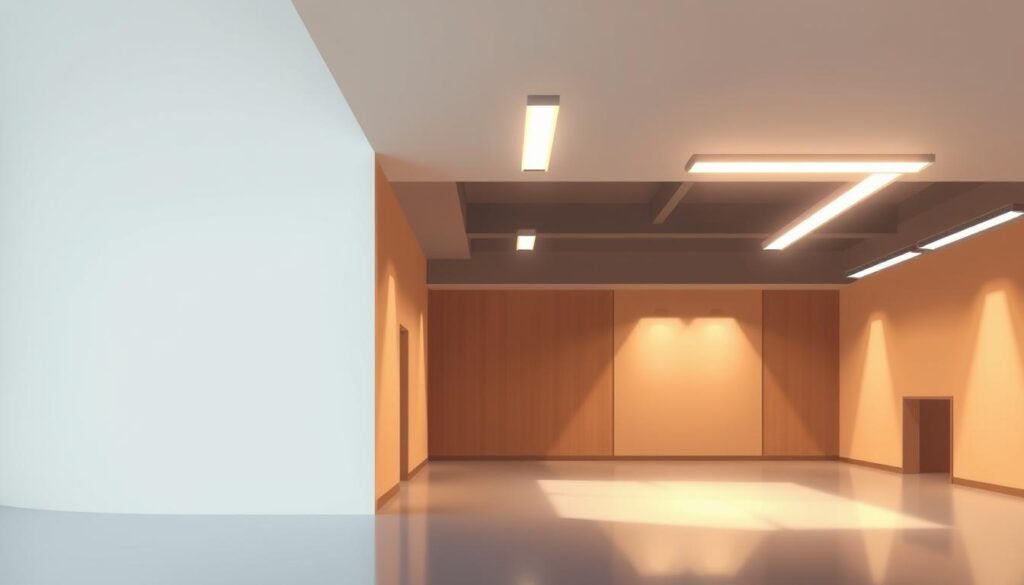
Installation and Maintenance
It’s important to know how to install LED linear fixtures right to get their full benefits. Smaller setups might be good for DIY, but bigger ones often need a pro’s help. Always think about safety and following rules during the installation.
DIY vs. Professional Installation
Choosing DIY or a professional comes down to a few things:
- Complexity of the Setup: Simple jobs, like small rooms or low ceilings, can be cheaper with DIY.
- Technical Proficiency: If you’re good with electrical tasks, DIY might work for you.
- Safety Considerations: For high or big spaces, it’s safer and smarter to use a pro. They make sure everything’s safe and up to standard.
Linear LED high bay lights are great for big places with high ceilings, like factories and large shops. They give lots of light. You can hang them up with chains or use U-shaped brackets for mounting.
Maintenance Best Practices for Longevity
To keep LED linear fixtures working well, they need regular care. Here’s how:
- Routine Cleaning: Clean them often to keep them bright and working well.
- Connection Checks: Check the connections to make sure they’re tight and not rusty.
- Heat Management: Watch the temperature to help them last longer.
Linear LED fixtures last a long time—often over 50,000 hours and use less energy. Sticking to these care tips can make them even better and more efficient.
Smart Linear Lighting Solutions
Smart lighting technology is changing how we see and control light. These apps allow you to control your linear lighting systems let us manage lights from afar and use less energy. They make spaces more flexible with automated setups and remote changes.
Overview of Smart Lighting Technology
Smart lighting means using clever tech to use less power and improve our experience. It saves up to 30% energy in offices with smart controls and sensors. In places like warehouses, savings can go up to 60% by dimming or turning off lights when no one’s there.
Advantages of Smart Control Systems
- Reduced energy consumption: By adjusting light levels based on room use and daylight, we save more energy.
- Enhanced well-being: Lighting that mimics natural daylight supports better health with adaptable light patterns.
- Customisable ambience: You can create special effects and animations with RGB, RGBW, and CCT lights, making spaces unique.
- Seamless integration: Systems like CASAMBI make setting up across projects easy, connecting various products and control options.
- Optional CASAMBI integration: Our luminaires have CASAMBI nodes available for piring with the CASAMBI app, making it a perfect choice for those that want to use Casmabi wireless lighting control.
In 2024, LED is leading in linear lighting because of its energy saving and lasting qualities. Modular designs give flexibility for homes, businesses, and big projects. With a focus on being green, LED lighting is at the forefront of eco-friendly designs.
| Feature | Benefits |
|---|---|
| Energy Savings | Up to 30% in offices; up to 60% in production areas |
| Health Benefits | Human-centric lighting improves well-being |
| Customisation | RGB and CCT programming for tailored environments |
| Integration | Compatible with various lighting control systems |
| Advanced Functionality | Motion and ambient light detection capabilities |
Safety Standards and Regulations
Making sure safety standards and rules are followed is key in setting up LED lighting systems. It’s important to follow the rules set by groups like the British Standards Institution. This ensures safety and that everything works well. Knowing about lighting design helps make both safe and efficient commercial light setups.
Compliance with Lighting Standards
Choosing the right light levels needs knowledge of specific rules. Different tasks need different light strengths. For instance:
- Process control rooms need about 300 lux.
- Corridors should have around 50 lux.
- Studying detailed drawings requires up to 750 lux.
Businesses must make sure there’s at least 11 cubic metres of space for each person in a room, following the Approved Code of Practice. This avoids tight spaces, which can make people unhappy at work and lead to taking more days off.
Check your own building’s lighting and emergency lighting compliance today with our free tool.
Importance of Proper Installation
Installing lighting correctly is very important. If it’s done wrong, lights can cause glare, making it hard to see. It’s a good idea to change lighting levels slowly so your eyes can adjust properly. Sticking to safety rules and keeping lights in good shape helps avoid problems like eyestrain and headaches.
Employers must make sure lighting is safe and manage any health risks related to it. This involves thinking about:
- How the lighting is designed
- Plans for emergency lighting
- Keeping lights well-maintained
By paying attention to these points, businesses can create a better workplace. Following the rules ensures the safety of employees and makes everything run smoother.
Common Questions About LED Linear Lights
Addressing common queries about linear lighting helps ease uncertainties. People often wonder about its features, costs, and how to install it. By providing clear answers, we help make choosing energy-efficient lighting easier. Additionally, we offer troubleshooting tips for maintaining its performance.
FAQs on Features and Pricing
Understanding the features and costs of LED linear lights is vital. Here are some frequently asked questions:
- What are the main advantages of LED linear lights? They use less energy, last longer, and require less maintenance than traditional lighting.
- How do pricing structures for linear lighting work? Costs vary by design, brand, and technology. Modular options might cost more upfront but save money in the long run on energy bills.
- Can LED linear fixtures be customised? Yes, there are many ways to adjust them for different spaces, like offices or warehouses. This helps create the perfect lighting setup.
Troubleshooting Common Issues
LED linear fittings can occassionally have problems. Here’s how to solve some of the most common ones:
- Flickering Lights: This can happen if the wiring is poor, connections are loose, or the LED driver doesn’t match. Make sure everything is connected properly and the power supply is correct.
- Buzzing or Humming Noises: These noises usually come from loose connections. Double-check all wiring and tighten where needed.
- Inadequate Brightness: If the lights are too dim, it might be due to the wire size, driver compatbility or how long the run is, causing voltage drops. Looking over the wiring setup can help.
- Incorrect Colour Display: There could potentially be a bad batch of LED’s – get in touch with the manufacturer so they check the reel code and trace the batch of LEDs.
Understanding key points about LED linear fixtures helps improve their performance. By addressing these questions, customers can make better-informed decisions on energy-efficient lighting. This prepares them to welcome advanced lighting technologies.
| Issue | Possible Causes | Solutions |
|---|---|---|
| Flickering Lights | Poor wiring, loose connections, incorrect driver | Check connections, replace driver |
| Buzzing/Humming Noises | Loose electrical connections | Tighten loose connections |
| Inadequate Brightness | Voltage drops due to wire size/run length | Review wiring setup |
| Incorrect Colour Display | Mismatched wiring, insufficient power | Check wiring compatibility |
Conclusion: The Future of LED Linear Lighting
LED linear lighting is entering a new era. Trends for 2025 show slimmer designs and natural colours. These advancements suit our goals for green, efficient lighting. Smart tech and modular systems also add great design flexibility.
Emerging Trends in Lighting Technology
LED linear lights are now more versatile, fitting various spaces. They blend minimalism with powerful features for subtle or bold looks. Whether hanging or flush with the surface, they offer modern style and seamless integration.
Why Choose LED Linear Lighting for Your Next Project
Choosing LED linear lighting is smart for several reasons. These lights use 75% less energy than old bulbs, saving up to £45 per bulb over time. With smart controls, you manage energy use efficiently, ensuring savings and embracing sustainability.
FAQ
What are the main benefits of using LED linear lighting systems?
Linear lighting systems are more energy-efficient than traditional lights. They last longer and produce less carbon. Plus, they make spaces look better and can be used everywhere, from offices to shops.
How do LED strip lights and tape lights differ?
LED strip lights and tape lights are quite similar, both offering flexible lighting. However, tape lights have adhesive backs for easy sticking. Strip lights can be rigid or bendy, depending on where you want to use them.
How can I choose the right colour temperature for my space?
The right colour temperature depends on your space’s use. Warm temperatures, about 3000K, are cozy for lounging areas. Cooler temperatures, near 4000K, help you focus and are great for workspaces.
What are the long-term financial benefits of switching to LED linear lights?
LED linear lights use up to 75% less energy than old-school bulbs. They also last longer, with about 25,000 hours of light. This means big savings over time.
Is professional installation necessary for LED linear fixtures?
For simple setups, you might manage a DIY installation. Yet, for big or complicated systems, it’s wise to hire a pro. This ensures safety and the best performance.
What smart lighting technologies are compatible with LED linear lights?
LED linear lights work well with smart tech. They let you manage lights remotely, set schedules, and adjust lighting based on room use and daylight. It’s all about making life easier and saving energy.
How do linear lighting systems comply with safety standards?
It’s key that LED linear lights meet safety standards, like those from the British Standards Institution. Following these rules during installation keeps everyone safe and makes sure the lights work well and last.
What should I do if my LED linear lights experience issues?
If you’re having trouble, start by checking connections and the power source. Keep your lights clean too. Stuck? It might be time to call in an expert to avoid further issues.
